Gravity‘s Astronaut Consultants Discuss the Science of Space
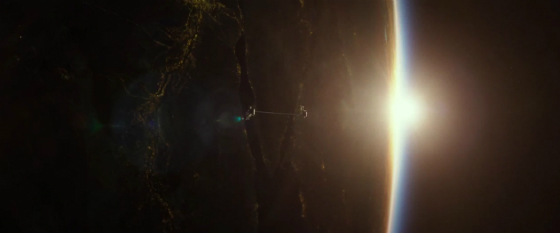 |
In the upcoming movie Gravity, George Clooney and Sandra Bullock play astronauts whose shuttle is functionally wrecked by space debris, and must make their way – if they can – to one of two orbiting space stations to survive. Review to come, but I can confirm this is not like Open Water, where the characters were entirely dependent on an external rescue: they know what they need to do to stay alive, and fight for that goal. It is also more scientifically accurate than the trailers might imply – unlike what we’ve seen, the crashes in the movie make no noise.
To discuss the accuracy of the movie, Warner Bros. held a press conference yesterday morning with two astronauts who assisted in the film’s research: Cady Coleman and Michael Massimino. TR was one of a select handful of media invited, and we’re pleased to bring you the complete Q&A. Minor Gravity spoilers are within, though nothing about the fates of the main characters, which I would never spoil except by request.
[All images courtesy of NASA unless specified otherwise]
Cady Coleman: My name is Cady Coleman, and I am a NASA astronaut, formerly Air Force; a chemist in the Air Force. I went on two space shuttle missions, and then a six-month expedition to the space station, and my connection here, I guess, is that – first of all – there’s a pretty marvelous movie about space coming out. It was really neat for us to be a part of. When I was up on my space station expedition, Sandra called – well, we ended up talking, I actually called her – because our families met each other and so I got to talk to her a little bit about what it really felt like to live up there and move around up there.
Michael Massimino: I’m Mike. I’ve flown in space two times on the shuttle to the Hubble space telescope. I enjoyed the movie. Are you allowed to say that? I’m not a critic. I really enjoyed the movie. I liked the actors saying that they should – all of you have seen the movie, right? I don’t have to worry about ruining it for you. But the actor with the telescope made me feel like I was back there, but of course after whatever amount of time, I was glad I wasn’t back there. But that’s where I come from.
Q: I wondered if you have any advice for a woman to struggling for life in zero gravity? How do you play that?
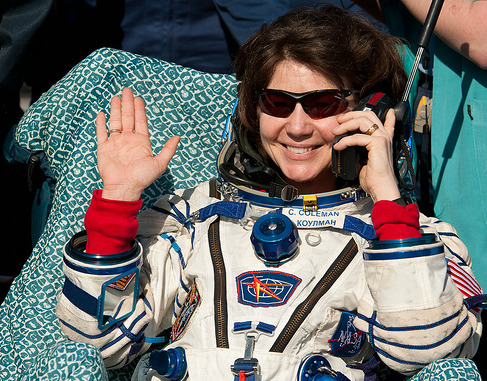 |
CC: I think the first part of that is the key part – the struggling for life, and that it actually transcends whatever environment you’re in. I don’t think it matters whether you’re in your house and not wanting to come out, or functioning in a world that’s actually closed up inside yourself, or in outer space. So that part, I just thought she did so beautifully, and it was really interesting to me to watch. And I liked the fact that the environment – I certainly, I love space, and I love that they made this movie, because it brings, I think, a lot of people from here on Earth up to space.
Mike and I have a very special job, where not too many people get to do it. We’re both pretty social folks, and there’s a lot of people I would bring with me, if I could, and I can’t. In this movie, my mother will get to understand a little bit about what it was like for me. Not the disaster kind of things! [laughs]I think they were so great about the environment, and the visuals are astounding, that the zero G part didn’t distract, and yet it was a real interesting place that she was.
MM: I’m afraid that my mother is going to think that I actually broke the telescope. [laughter]“Is that happening?” I’ve got to keep my mom away.
Q: As a follow-up to that, when she gets to the first space station, there’s some Russian, there’s some Chinese – when she enters those pods, you see so many things floating around from previous people who were living there or inhabiting that space, do you see things floating in space?
MM: I don’t think there was very much time to clean up. It looks like they got the hell out, so…I guess that’s what I think.
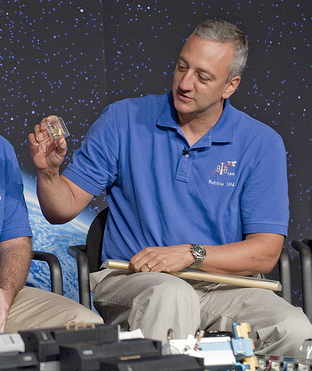 |
CC: I was going to say that that visual, the first time in the shuttle, when they get on the shuttle and of course the shuttle’s open, I don’t know if you meant that in the shuttle everything was floating, and then in the station everything was floating and out and tangled and all those kinds of things, and that is so absolutely foreign to the way that we live up there, because anything that is floating untethered will be gone. You will never find it! There are certain ventilation paths you can follow, and that’s where you find the stuff that you lose because…
MM: In the air filter.
CC:…yeah, exactly – in the air filter. But to me, that was actually very emotional to see in the movie, it was the epitome of devastating, just that visual, because it’s just not going to be that way in a space ship unless something has gone very wrong.
Q: I was referring to those two other ones.
MM: I’m assuming that’s what – I assumed everyone had to get out, because they were in a debris field, and it was time to go home.
CC: I assumed that no one made it.
MM: Well, there were no bodies floating out there.
CC: I know, and I wondered kind of why they didn’t do that, but they didn’t have any way to go home.
MM: Maybe they only had three people? We’ll get into the science here. [laughter]I think what you’re seeing is an example of how astronauts watched the movie. Because I was like, “I would have done that differently. I wouldn’t have done this. Why is she on such a long tether when he was …” – things like that. We could probably go on for a couple of hours, so we won’t force you to listen to us.
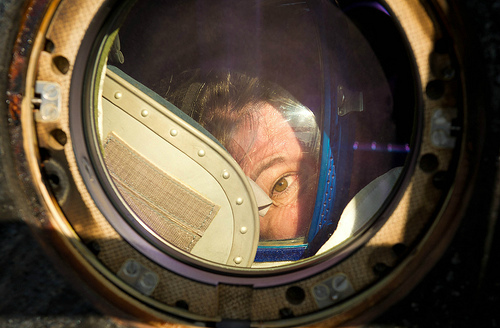 |
Q: How likely is this – I know it’s a drama, but how likely is this to happen in space? If I were a child watching this, I would never want to be an astronaut! Are you afraid it’s going to stop people? With the Russians now, we’ve cut back so much on our space program, we’re depending on them to even get to the space station and back, which is infuriating – can you talk a little about that?
CC: Let me address the infuriating part, and then Mike can talk about space debris. You know, it would be nicer if we were launching from the US, but all of us here in this country have a lot of competing economic concerns, and a dozen years ago, every single person that works at NASA can tell you that on this day, we would have no space shuttle, and no way to launch from American soil. It’s a choice that we all made to not fund the new program to the extent that it would be ready now.
Now, you can’t go back and rethink that. It just wasn’t the decision that could be made at the time, but things are actually, I think, in a pretty exciting state, and as much as I loved the space shuttle, and as much as it did for us – building a space station, bringing a number of different kinds of people up to space – it took enormous amounts of resources, people and money…every single time Massimino left the planet. [laughter]No, but seriously…
MM: My bones are bigger. I eat more food.
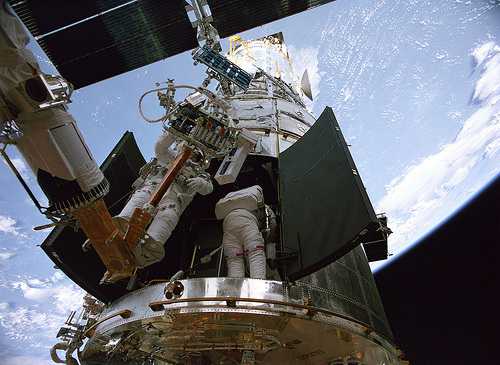 |
| Massimino and colleagues in the documentary Hubble 3D |
CC: That’s true. No, it’s just an enormous amount of resources, and it was really time to retire the shuttle. Right now, we’re in this period where it would be really nice if we had the new vehicle, but the new vehicle is coming. The test flights for the new vehicle start in 2014. That is soon. So it’s really soon, and when you look back at this with a longer lens, so to speak, it will be a bump, it will be a time; it’s a challenging time in terms of people not working immediately, right now, on a vehicle. But in the meantime, the things that we know how to do, we know how to get people up to space, and we know how to get stuff up to space, and that’s supplies, and we’re letting our…are you looking at me like I should go faster?
Q: Oh, no!
MM: I’m waiting for the microphone. Usually I’m loud enough that I don’t need a mic. I’m afraid I’m going to hurt your ears.
CC: So anyways, we know how to get people and stuff up to space, and that’s what we’re having our commercial partners do. It’s just companies like SpaceX, Orbital Sciences, Sierra Nevada, Boeing. They – it’s not that we can do that easily, it’s not that we can do it casually, but it is a known thing and these companies can do it faster. Faster, better, cheaper is not always the most popular phrase but it’s true. They’re very flexible and they’re interested in making – tomorrow is a very big day for the Orbital Sciences company – they are the second company to send commercial launches to the International Space Station, and their launch is at about 10:50 Eastern time, and they will launch on the Antares rocket from Wallops [Flight Facility], in Maryland outside Virginia there on the coast. Their supply ship arrives at the International Space Station on Sunday. Karen Nyberg and Luca Parmitano will be controlling the robotic arm to capture that thing, bring it on board, unpack the supplies, and then repack it with trash and send it off with trash. And they’re doing it in a way that should be done.
So that’s where we are now, is trying to make sure that our commercial partners don’t reinvent the wheel. That’s actually my job right now at NASA when I’m not at the movies, is being in charge of the – basically everything the crew does with those new supply ships, including the transition as we start to have people on those ships, and so it’s actually a really busy week for us, and we’re pretty excited about grabbing the Cygnus – Cygnus stands for swan, and that’s a pretty cool thing.
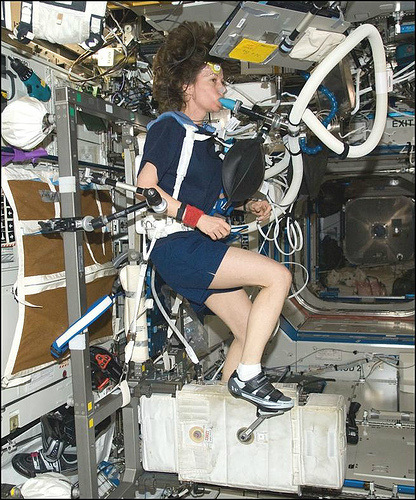 |
So it is a pretty tough time, infuriating, or whatever. At the same time, having had this view of the planet, where you look back and see the whole thing, it’s actually a lot harder for me to think of myself as being from just one place. I didn’t care where I launched from, I just wanted to go, and I wanted to go and live there, and I trust the Russians, and I launched with them, I landed with them. You know, it’s the International Space Station, 16 different countries, all of these countries have different ways of doing things, but it’s working. I mean, not only is the crew working together up there – there are usually six people up there, right now there are three, because the next three will launch in about a week, we’re in the midst of changing crews – but on the ground this phenomenal thing is taking place where 16 countries are deciding with these six people will do every single day. They’re making time-affective decisions, and it’s a really extraordinary kind of thing, and what I love about this movie is that whether they’re having a bad day up there or not, at least folks down here understand that people on this planet are exploring. It has risk, but we’re exploring because we just have to, and it’s very special.
Q: Mike?
CC: Space debris. [laughter]
MM: I got to fly on the shuttle twice, and I think it’s a magnificent space ship. I think if you could put a coolness factor on a space ship, I think the shuttle blows everyone away; it’s the coolest thing we’ve ever had and will have for a while. As Cady said, it had some limits – it’s a bit dangerous, it’s a bit expensive, it’s time to move on, but it was a magnificent ship. It launched like a rocket, it took seven people with her, lots of cargo could go with her when the shuttle flew; it kept us safe in orbit. It went from a large vehicle to kind of like a space station – kinda/sorta, a small one – it allowed us to build the International Space Station, launch and repair mobile space telescopes, which were the missions I was on. I remember thinking of this on one of my last flights, of everything that this space ship had done for us, and if I was outside and I could have, I’d have given her a kiss. As I was looking out over the front windows, looking at Atlantis written on the side – what a magnificent machine. But that time is done, we’ve got one from here to Los Angeles that you can see it in a museum, and at other points scattered around the country. But it was really a great space ship, I think.
As far as the real world risk – so on my flights on Hubble, we did, very much – we were concerned about risks of getting hit. In fact, I remember my first flight, which was before the Columbia flight, before the Columbia, we actually flew on Columbia – we were the flight before we lost Columbia – and I remember I was a rookie on that flight, and I was with a lot of experienced guys, I was really the rookie – these guys had flown multiple times, and lots of space walks. I remember our first meeting, the four space walkers got together with our lead space walker said to us, “We lost a crew in March; I think the next time we’re going to lose somebody is during a spacewalk, and we’ve all got to stick together and make sure it don’t happen to one of us.” And so we did whatever we could to make sure that when we buttoned someone up inside of their space suit, that they were ready to go, everyone’s comfy, and we knew the checklist, and we knew every emergency, and we practiced and practiced and practiced. And one of those things that we looked at and were concerned about was getting debris hit.
Now we see a very sensationalized version of a debris hit in the movie. So when that happens, it’s kind of like, alright, God, I get the message. But there was a reasonable chance – not a very large chance – but when we looked at the telescope, we were space walking on it, the high gain antenna, which is a big antenna dish, has a hole about this big in it, about the size of a silver dollar, from a micrometeorite that came, or was coming towards Earth and clipped it on the way in. It’s peppered with these dings.
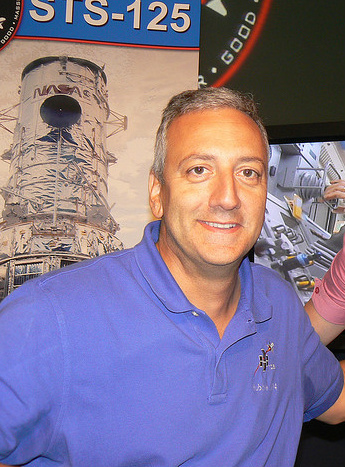 |
| aschwortz |
We took out the wide-field camera, which has an exposed radiator, and when I saw it on the ground at the Jet Propulsion Lab down the street here in Pasadena a few months later, and I saw all these little…it looked like some kid with a BB gun got at it. It’s like, what, you breezed through the wrong neighborhood? What happened? [laughter]But it was from space – it was just debris that had pinged it. So it was something that we thought about, and practiced rescue – if you have an incapacitated crew member, for whatever reason, a debris hit or something else – we practiced the rescue of one crewman, crewperson, rescuing the other crewperson, and what the group inside would do, what the ground would do. Cady’s gone through that same training. It’s something we have to be able to do, and demonstrate, before they even let you go into space. So it is something that’s on your mind. It’s a real risk.
The movie shows that space can be a very dangerous place. It takes you to the extreme. But these are real risks, you know, these are things we think about – maybe not to that extent, because this was a really colossally bad day [laughter]. But these are certainly things we think about.
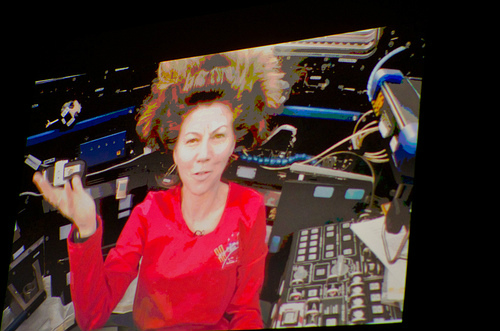 |
| Dray-Dray |
Q: I was fascinated by the physical properties that are depicted in this film, and the concept of momentum. Momentum creates a lot of the dramatic tension in the film – if you are going a direction, you’d better like it, because that’s the direction you’re going to be going for a while.
MM: In the actual movie?
Q: Yeah. First of all, describe how you see it, as far as does the film depict this the way it really is, and also, how hard is it to get used to that concept of momentum and the way it works, and how you have to commit to a direction?
MM: You’ve got to be careful, because once you – you’re right, it’s funny, when you mentioned that, I thought of a story. We had a little thing, we had a rendezvous with Hubble, you’re building momentum in different directions – you’re traveling at 17,500 miles per hour, 350 miles above the planet, and you gotta get this target, and you only have a limited amount of fuel on board the shuttle – at the time, we were using the shuttle – and you could run out of gas. And then you would feel really foolish, like “Sorry we wasted the launch – we gotta come home now! We gotta get gas.”
So you want to get there, and you’re right – so we had a little saying. If you pick the wrong direction, if you start doing too much, wasting the fuel, so Scoot [Scott “Scooter” Altman] came up with this saying, he said – let me see if I can get it right – “The longer we do nothing, the less we’ll have to do later.” [laughter]Eventually, it was like everyone just shut up until we really know what we’re supposed to do here, or we’re going to drift for a while until we figure it out, and not waste any more gas! That actually was a good thing to remember, because it allowed us to manage our fuel better.
CC: Mass, talk about it from being in the space suit, which weighs 300 pounds – that kind of person moving limited, which Mike has done, having done space walks, then I’ll talk about inside, which is easier.
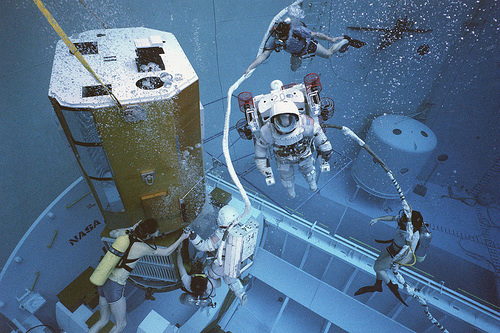 |
MM: So one of the things we do is, you’re talking about the moving part – so for the space walks, when you practice – we practice in all different facilities, so I describe a spacewalk as like playing in the World Series. We’re all Americans here? This is domestic press? [laughter]So playing in the World Series or the Super Bowl, let’s say…
CC: Baseball?
MM: Baseball is the World Series. Super Bowl – you know that? OK, Super Bowl, without ever playing on the field, never practicing on the field. Usually a football team gets to practice on the field, but we can’t go practice in space. You go up there and it’s the big day, right? So we practiced in lots of different facilities, and where we practiced most of our movement is in the pool. We have this gigantic pool at the Johnson Space Center – it’s 200 feet long, it’s 100 feet wide, it’s 40 feet deep, it’s like a lake, it’s gigantic, you could fit a space station, and a shuttle and a Hubble inside so we could practice our spacewalks.
So when you’re in the water, and you practice this moving around, what you have to be careful of in the water is – I’ll let people think, physics-wise – you’ve got water to dampen your motion. So as you move along, you’re fighting the weight of the suit and the water also dampens out your motion. If you try to move the same way in space, you’re going to go for a ride! A little motion is going to take you a long way. So you have to kind of relearn that.
In every spacewalk, we do for the person’s first time in a spacewalk, when you’re a first-time space walker, you get 15 minutes of what we call translation adaptation. We try to do a lot of practice inside the space ship, readjusting to what it’s like to move, but when you get out there, you have to go very, very carefully. One little push, you can launch yourself. You have a safety tether, but you don’t want to rely on that. You want to move very, very cautiously, with a little grip, and you can move very, very easily in space when you do it that way. The safety tether is there to save you, and I felt if I were to make a mistake and do these somersaults and flips, I was pretty confident that the safety tether would bring me back in, but I wasn’t as confident in my heart. They may get me back; I’m not sure what’s going to be on the end of the line! [laughter]The thing they show in the movie of Earth, space, Earth, space (Sandra Bullock’s POV while spinning) – that was one of my nightmares, I don’t want that, I don’t ever want to see that! So you go very, very cautiously so you don’t have that problem.
CC: To give you an idea of how little it takes to move anywhere, the example that I gave Sandra, and I had forgotten that I talked to her about it until I talked to her yesterday, was that, I mean, I have longer hair than Mike, and it would hit things and come out different places around the space station. You could take a single hair, and if I basically put it up against a hand rail or something that was sort of sticking out, and just pushed – that hair would push against the handrail, and I could move myself across the entire module until I ran into something else. I could move down the entire length of the space station based on my push against a single hair. If I did it hard enough I’d break the hair, so you had to be careful, but it takes so little.
And so when you’re going someplace, you’re just using a pinkie. You get better, and you have a little contest, because we’re all pretty competitive, about who can push off and go the longest without touching anything. It got me far enough to find the most amazing thing in the paper supplies, office supplies drawer – it was a rubber band that was this thick, and 12 feet long. A giant person slingshot. [laughter]We actually were too busy, so we never got to actually go and use this, but I always tell people that some of the most remarkable things about outer space and being out there is the magic of flying from place to place. It is like living the life of Peter Pan. And it made me, basically – if I could have had my family out there, I never would have come home.
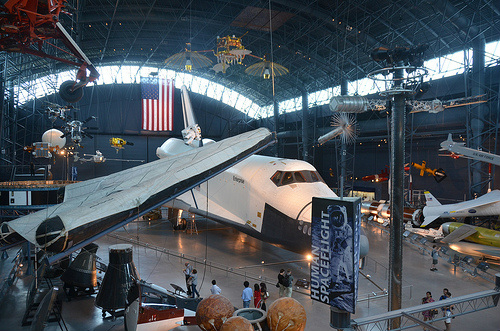 |
| Chris Devers |
I have to say one thing that I think is important, based on your question “Are kids going to think that space is scary and not want to be astronauts?” And I’ve thought about this some, and when they see a movie with a lot of action and things blow up and big car chases, a guy named Bruce makes a lot of those movies, right? So when they see that movie, does it make them never want to get in a car? No. I think it has to do with familiarity, that space is very unknown, we don’t know much about it, and it’s just maybe scary in that respect, to a lot of people. What I’m hoping that this movie will do is make space more familiar to folks. In fact, it is just kind of normal that they’re up there, and in fact there have been a lot of people up there on different space stations, different space shuttles, we’re fixing things. So I’m hoping the familiarity helps, and I also am hoping that, I’m hoping that it doesn’t turn out that way. I think for a special group of people, which would be our kids, I think it’s important, us meeting the astronaut family. I think it’s important, I’ll make sure that my son sees this movie early, and with me, and that we talk about what things are really like, because people will ask him about it.
MM: I think the thing I want to say is, remember, it’s a movie.
CC: Yes.
MM: That’s one thing. My daughter actually has seen the movie, and she called me and she said, “Dad, I don’t want you to go in space anymore!” I said, “It’s a movie! It’s a movie!” That’s my daughter; she’s concerned about her dad. My son, who’s 18, has not seen the movie, but I suspect that when he sees it, he’ll say “How come you don’t get to fly around like George Clooney?” I think people will realize it’s a movie and I agree with Cady that it shows enough elements of the positive things that go on in space, how cool it is – George Clooney is a very cool astronaut, by the way – I think it shows enough of the camaraderie, the beauty of space, and it’s going to get a lot of people, it’s going to attract a lot of people into the theater to see what space is all about. I think it’s going to encourage a lot of kids to go into it. And if kids are worried about it, I’d say it’s only a movie.
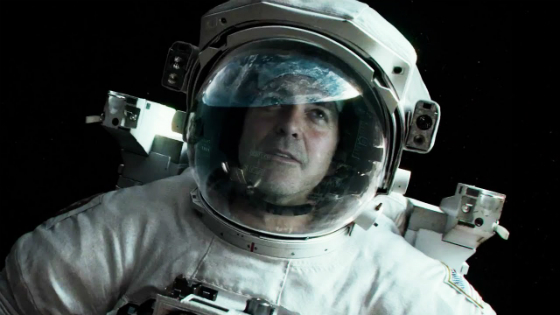 |
Q: Up until now my idea of an astronaut was Jack Nicholson in Terms of Endearment.
MM: Yeah, but now we’ve got George Clooney.
Q: It’s a very powerful story, but I kept thinking while watching the film that it’s almost a religious experience, to see the world in this fashion. So for both of you – why do it? Knowing that there are these risks, and it’s this very unknown environment that could do a lot of harm to you, why did you want to become astronauts?
CC: I grew up with a dad who explored the ocean. He was in charge of building habitats where men, it happened to be men at the time, first lived under the sea, so it was a little bit normal in my family to think about living someplace strange in a kind of challenging environment. And so I think that really was in my head. I just think it’s really essential for people to explore. I love being a chemist, and at the same time I wanted a little more adventure in my life, probably. And I trust the people that built these things, I trust the people that design the missions and do the calculations about orbital debris and all those things, and I just think that people are not meant to stay on this planet.
I also think as a scientist, I’m really dedicated to the experiments, as all of us are, that we’re doing up on that space station. You can argue about money, or anything else you want all day long, but we were doing experiments up there that you cannot do down here on the Earth, and it means a lot to me to be a part of those experiments. Looking at liquids – what do liquids really want to do, those lessons come right back down here to Earth. Understanding every process that involves flow through a pipe; what happens to the edges of that pipe; oil collection; cleaning soil; manufacturing something – everything flows through our pipes, everything has to do with really tiny forces with liquids that we can’t measure down here because gravity just masks them, it’s so big and those forces are so small. So there’s that, there’s combustion research – there’s some pretty good fire in the movie – understanding how things burn both so we cannot burn up in space, but also how to burn things more efficiently down here. Someone has actually produced measurements that give you an estimate in less than a second down here on the Earth for combustion, to decide the scope of alarm, we need two data points, and you take them like this [snaps fingers]. We take those measurements over 30 or 40 seconds up in space, because without all the light air rising and the new fuel coming in, all that really dynamic process down here on the Earth, we can actually study how combustion and soot production happen. So the mission is just so important to me and it is hard to leave your family, whether it is to come here for the weekend and stay in a very nice hotel and for a really good purpose, or whether it’s to go on a mission – I think what we’re doing on the International Space Station together with these countries is really important. And I think that what we’re going to do is really important.
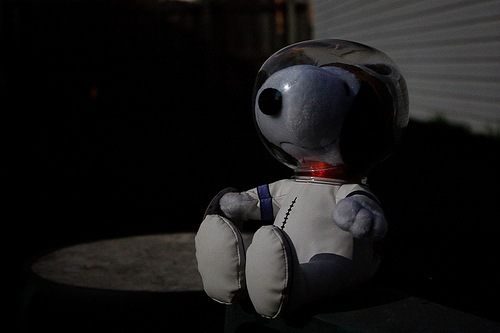 |
| DangerBarrow |
MM: Yeah, I was old enough to remember the moon walk. So I grew up – I was six years old when Neil Armstrong walked on the moon, and it’s pretty cool. My mom made me an astronaut costume; she actually converted it from an elephant costume that I wore as part of a circus group. The kids that had talent, like George Clooney, when he was a little kid, probably had the starring role – I was an elephant with all of the other kids in New York. She cut off the tail and converted it. She got my father’s old medals from the Korean War and put it on to make it look – so that was that, and I’d carry around a picture of my astronaut Snoopy, and I still have it. I took it to space with me. Snoopy looks like he came out of the movie – he has a broken leg, and his helmet is gone. I don’t know what happened. But he came to space with me on my most recent mission.
So I was one of these kids, but then as I grew up on Long Island, and I told you I have teenaged kids, so I didn’t know what the heck I wanted to do in high school. But when I was a senior in college – here comes a movie plug, are you ready? – I saw The Right Stuff. I remember sitting there with my wife – at the time we were just dating, but it worked out alright – so we were watching that movie, and the views of John Glenn’s space ship, and the camaraderie between those original seven astronauts, I was like, I want to do that. It rekindled my hope and dream, and so I started to pursue it.
So as far as the risk and everything, I know that there’s a risk, and I knew the day that I was getting on the space shuttle what was happening. And the days that we space walked, I knew what could happen, but I think the message to kids is that I sometimes, I think that the dream is worth the risk. And in some ways, I feel sorry for people that don’t have a dream that they would not risk everything for. I mean, I feel so fortunate to get to do what I do, I think that’s what makes life worth living. And in some ways I feel sorrier if you don’t have that thing that you’re so passionate about. I don’t know if you feel that way about your jobs, because whatever your passion is, that’s what you need to do. For me, that’s what mine is. If it comes with a risk, it comes with a risk – that’s all you can do about it. Um…something else I was going to say, but I forgot. But anyway, that’s what inspired me to become an astronaut, and I think it’s definitely worth taking that risk and pursuing it.
Q: Do you still have your Snoopy?
MM: I still have my Snoopy! I took him to space with me. I didn’t bring him here with me, though – I left him at home. His leg got broken – it’s almost as if he was in the movie with George and Sandra. Oh, by the way, I wanted to add, by me seeing The Right Stuff, and I got my dream rekindled, I become obsessed, I went to grad school, I started applying – this is why I wanted to be in the space program. As to your other question, I think that some kids are going to see – if I saw George Clooney when I was a 19, 20 year old kid, I would want to be like that guy. He was a cool guy, and they worked together as a team, and I would say the same thing for Sandra Bullock, for young girls that age – little boys get attached to heroes, so I would say that if I were seeing him – real astronauts are not always depicted very much, so people don’t necessarily get to see how it was around the house, but we get to see George Clooney up on the big screen, and I think that’s going to do more to inspire – and Sandra Bullock, I think both of them, those characters, those actors playing those characters, what we see on that screen, is going to inspire a lot of kids.
CC: I was going to add just one more thing to that, which is that to me, I didn’t want to be, I was actually on Long Island with the moon landing as well, and down the cove, isn’t that weird?
MM: That was you?
CC: That was me! [laughter]
MM: You were just around the corner! What were you doing there?
CC: My dad was in grad school, in post-graduate school.
MM: Really?
CC: Yeah. I didn’t grow up wanting to – I talk about my dad being an inspiration, but I didn’t grow up thinking that I could be an astronaut. It never, ever, ever occurred to me until I went to college. I think I’m older than Mike – I was born in 1960…
MM: I just look a lot older!
CC: …but that’s why, one of the reasons, this movie is so significant. I’m a reasonably intelligent person that probably was reasonably intelligent when I was nine, and it never occurred to me, and it wasn’t until I went to college and met Dr. Sally Ride, the first American woman astronaut, and a light went off, and I thought, “I want that job! Maybe that could be me.” And it was purely because I could relate to her. We still need that. Our girls still need to see somebody and go, “Maybe that could be me.” And I know that guys need it too, but movies like this where you see people – I mean, there’s the whole space thing, but you see people solving hard problems together, you see them being vulnerable to each other, and you see them doing things when they’re not sure that they can, and those are really important lessons and examples for our young people, and I think that it’s a really important presence for the girls of the planet.
Q: You talked about the preparation that you do on Earth, but one thing that you cannot replicate is the actual enormity of the void of space. What were your experiences when you first space walked, or when you got up there? That was actually the most terrifying part of the movie for me – the idea that you can’t get out of there if you don’t want to be there.
MM: You’ve brought up something that I’ve said a lot, you’re really prepared to do your job. On my very first spacewalk, we had to change out a reactor that spins around the telescope. We had practiced this on the ground, and I remember the thought before that first spacewalk was, as I was closing the door, about the go on the telescope, and I realized it was the first time I had done that, though it felt like I had done it a thousand times. They train you perfectly to do that job, but there is nothing that can prepare you to see what is around you. Even this movie, as good as it is, there’s no, the experience – there is nothing that can prepare you for that.
So that is kind of the wonder that gets exposed, and the opportunity to see the planet from that vantage point is just remarkable. I don’t know if I’ve told this story on the Earth, but I told it earlier, there are thoughts that went through my head, like when you first get to space, you’re looking through a window – if I’ve told this story before, tell me to shut up – when I first looked through the shuttle window, the first thing you want to do is unbutton and get out, especially if you’re a rookie – “Go, go look!” Everyone else is waiting – “You, go look, ’cause you’re the new guy!”
So I went up to the window, and it’s kind of euphoric, but it’s kind of like an aquarium experience. I can go to the bathroom, I can eat peanuts, drink – but you go out in your space suit, and it’s like you’re a scuba diver now – you’re interacting with the environment. And at the Hubble altitude, where at 350 miles you can see the curvature of the Earth, you can see its entirety – it’s big, your field of view – but you can see it as a planet, it’s like, whoa! It’s awesome, and I didn’t look much on my first spacewalk. On my second spacewalk, I took the time to really look, and the thought that went through my mind was if you were in heaven, this is what you would see. This must be the view from heaven, and this was just my reaction, what I was feeling, and it was replaced, and my thoughts are, it’s more beautiful than that. This is what heaven must look like. And that’s what I thought, looking at our planet, so that was the experience that I had. What was the other part of your question?
Q: Just what was it like getting acclimated to such an experience? Is there any kind of fear, because it is so radical and foreign?
MM: For me, the whole thing was, the emotion, the beauty, doing the work was so gratifying and so intense, and the views around are so awesome that I didn’t really get scared when I was there. The only scary time for me was the launch, the very first one. The day I woke up for my first launch, and getting out to the launch pad, it was a night launch, it was 5 in the morning, so we got on the bus at, like, 2 a.m., and there was one other rookie on the flight, Duane Carey, we called him “Digger,” he was our pilot. It was a few months after 9/11, and there was a lot of security. So there’s these guys – there was an attack helicopter – I sound like a civilian – there’s a helicopter that can do damage that was covering our bus, and there were guys with weapons, SWAT guys and stuff, and I turned to Digger and I go, “Wow, there’s a lot of security.” He goes, “Yeah, it must mean they’re worried about something happening. They’re here to protect us.” So I’m looking at them and I go, “I think they might be making sure we get on!” Don’t make a run for it! ‘Cause that guy is looking right at me with that thing, he’s not looking at the crowd.
So we get out to the launch pad and we get ready – there’s nobody around, I’ve been around the shuttle a lot, I guess it’s different now with Russia, but once they fuel the shuttle, it’s a couple of hours before the flight, everybody goes home, except for one guy – whoever has to stay there. But they get everybody out of there basically, because…
CC: It’s a bomb.
MM: Yes, thank you. I didn’t want to say it. It’s a bomb sitting there, and there’s nobody around. People come riding in on the bus, and they get off of the bus before they get to the launch pad, and then the driver really steps on it – you get out and he’s gone before you can say “Wait, I forgot something!” You’re there with a couple of guys in white suits who say, “C’mon, let’s go.” They’ve got paraphernalia to deal with. The thing is, it’s like, a beast – it is alive, it’s smoking and making noises, and groaning, and it’s dark, and I thought to myself, “Maybe this wasn’t such a good idea!” But once I got inside I was OK. That was the only time. Luckily, it was after there was no choice. “I have to go now!” They’d just come get me anyway, I might as well just go. That was the scariest time for me. Other than that, it was just an incredible adventure.
CC: It’s hard to follow that. It brings it all back for me. It’s a pretty wonderful description. I’ll be quick. An awful lot of kids ask if you get scared, and I tell them it’s not really about being scared, but there are times that I am worried. What I worry about, is I worry about making a mistake. I was the second person to catch a big telescope from a space station, and basically my way around doing that, around being nervous and having that nervousness distract me, is knowing that I’ve done all of my preparation, and I’m really ready. I’ve done all of my practicing, so I encourage the kids to do that.
In terms of just the wonder of being up there, I think that’s a really nice word to use. Even amongst ourselves, we all talk to each other before we go, people who’ve been, people who haven’t been, about what it’s like, and after I got back I decided that when I had talked to other astronauts about what being up there was like, they always had this certain look in their eyes, as if they knew a secret, and it wasn’t that they didn’t want to tell me, they just couldn’t. It’s just really hard to share. And when I got up there, I felt like I knew that secret as well, and it has to do with just looking from the space station, being able to not just look out a portal, where the world is going by quickly, but out of these cupola windows that are all around you, so you see a place that you love, maybe your home – for me, I’m from Massachusetts, so Cape Code is pretty easy to pick out. One guy on my first crew, he saw Massachusetts for the first time and he said, “Oh my gosh, it looks just like the map!” [laughter]I love that quote!
But it’s a really emotional experience to look out every day, look out this window and see places that you know and care about, and to know that everyone that you love and care about, except the other five people, are down there, and you see those places coming, and then they’re there, and then they’re going, all over the span of a minute or two – it’s a really special place to be, and this movie, I’m thankful that there’s a movie like this, because I think you get to see, if you can ignore the kind of sensational things that are happening, you get to see that real people are living in a very special place, and you see, I think, the specialness of that point of view, that visual field, and what it looks like and feels like to live in that very special place.
Gravity opens in theaters October 4th, 2013
